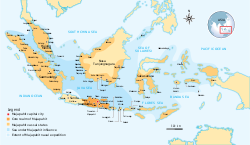Majapahit
From Wikipedia, the free encyclopedia
| Majapahit Empire Karaton Mojopahit Kerajaan Majapahit |
||||
|
||||
 Surya Majapahit¹ |
||||
| Extent of Majapahit influence based on the Nagarakertagama; the notion of such Javanese depictions is considered conceptual.[1] | ||||
| Capital | Majapahit, Wilwatikta (modern Trowulan) | |||
| Language(s) | Old Javanese (main), Sanskrit (religious) | |||
| Religion | Kejawen, Hinduism, Buddhism, Animism | |||
| Government | Monarchy | |||
| Raja | ||||
| - 1295–1309 | Kertarajasa Jayawardhana | |||
| - 1478–1527 | Girindrawardhana | |||
| History | ||||
| - Coronation | November 10, 1293 | |||
| - Demak takeover | 1527 | |||
| Currency | Native gold and silver coins, Kepeng (coins imported from China and later produced locally [2]) | |||
| ¹ Surya Majapahit (The Sun of Majapahit) is the emblem commonly found in Majapahit ruins. It served as the symbol of the Majapahit empire | ||||
| This article is part of the History of Indonesia series |
|---|
 |
| See also: |
| Prehistory |
| Early kingdoms |
| Kutai (4th century) |
| Tarumanagara (358–669) |
| Kalingga (6th–7th century) |
| Srivijaya (7th–13th centuries) |
| Sailendra (8th–9th centuries) |
| Sunda Kingdom (669–1579) |
| Medang Kingdom (752–1045) |
| Kediri (1045–1221) |
| Singhasari (1222–1292) |
| Majapahit (1293–1500) |
| The rise of Muslim states |
| Spread of Islam (1200–1600) |
| Sultanate of Ternate (1257–present) |
| Malacca Sultanate (1400–1511) |
| Sultanate of Demak (1475–1548) |
| Aceh Sultanate (1496–1903) |
| Sultanate of Banten (1526–1813) |
| Mataram Sultanate (1500s–1700s) |
| European colonisation |
| The Portuguese (1512–1850) |
| Dutch East India Co. (1602–1800) |
| Dutch East Indies (1800–1942) |
| The emergence of Indonesia |
| National awakening (1908–1942) |
| Japanese occupation (1942–45) |
| National revolution (1945–50) |
| Independent Indonesia |
| Liberal democracy (1950–57) |
| Guided Democracy (1957–65) |
| Start of the New Order (1965–66) |
| The New Order (1966–98) |
| Reformasi era (1998–present) |
Majapahit was one of the last major empires of the region and is considered to be one of the greatest and most powerful empires in the history of Indonesia and Southeast Asia, one that is sometimes seen as the precedent for Indonesia's modern boundaries.[4] Its influence extended beyond the modern territory of Indonesia and has been the subject of many studies.[5] German orientalist Berthold Laufer suggested that maja came from the Javanese name of an Indonesian tree.[6]
Contents |
Historiography
Little physical evidence of Majapahit remains,[7] and some details of the history are rather abstract.[8] The main sources used by historians are: the Pararaton ('Book of Kings') written in the Kawi language and Nagarakertagama in Old Javanese.[9] Pararaton is focused upon Ken Arok (the founder of Singhasari) but includes a number of shorter narrative fragments about the formation of Majapahit. Nagarakertagama, is an old Javanese epic poem written during the Majapahit golden age under the reign of Hayam Wuruk after which some events are covered narratively.[8] There are also some inscriptions in Old Javanese and Chinese.The Javanese sources incorporate some poetic mythological elements, and scholars such as C. C. Berg, a Dutch nationalist, have considered the entire historical record to be not a record of the past, but a supernatural means by which the future can be determined.[10] Despite Berg's approach, most scholars do not accept this view, as the historical record corresponds with Chinese materials that could not have had similar intention. The list of rulers and details of the state structure show no sign of being invented.[8]
Ming Dynasty admiral Zheng He visited Majapahit. Zheng He's translator Ma Huan wrote a detailed description about Majapahit and where the king of Java lived.[11] New findings in April 2011, indicate the Majapahit capital was much larger than previously believed after some artifacts were uncovered.[12]


Tidak ada komentar:
Posting Komentar